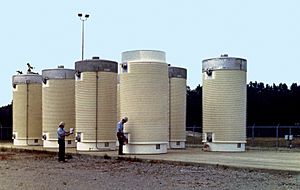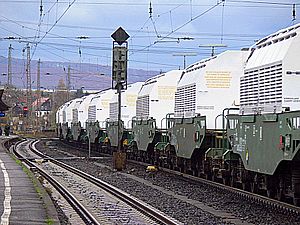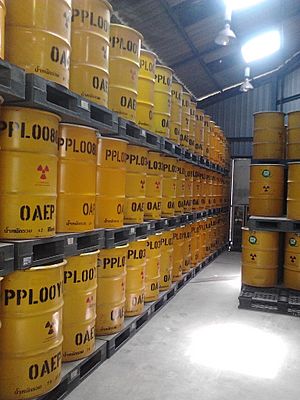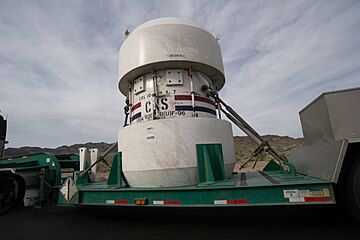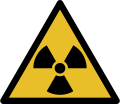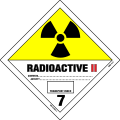Radioactive waste facts for kids
Radioactive waste is a type of hazardous waste that contains radioactive material. Radioactive waste is a result of many activities, including nuclear medicine, nuclear research, nuclear power generation, nuclear decommissioning, rare-earth mining, and nuclear weapons reprocessing. The storage and disposal of radioactive waste is regulated by government agencies in order to protect human health and the environment.
Radioactive waste is broadly classified into low-level waste (LLW), such as paper, rags, tools, clothing, which contain small amounts of mostly short-lived radioactivity, intermediate-level waste (ILW), which contains higher amounts of radioactivity and requires some shielding, and high-level waste (HLW), which is highly radioactive and hot due to decay heat, so requires cooling and shielding.
High-level radioactive wastes give off large amounts of ionizing radiation.
Radioactive waste is dangerous to the environment, and there are many regulations about transporting it, handling it, and processing it in such a way that the dangers are reduced. They can contaminate water and affect the living organisms. Storage of radioactive waste must be guaranteed for thousands of years, until it decays sufficiently to be safe to the environment and its inhabitants.
The time radioactive waste must be stored for depends on the type of waste and radioactive isotopes it contains. Short-term, radioactive waste can be stored on the surface or near-surface. Burial in a deep geological repository is a favored solution for long-term storage of high-level waste. Radioactive waste can be stored by deep geological burial or by dry cask storage. Dry Cask Storage is large cylinders of concrete and steel that are used to hold 10 or more metric tons of high-level radioactive waste.
In nuclear reprocessing plants about 96% of spent nuclear fuel is recycled back into uranium-based and mixed-oxide (MOX) fuels. The residual 4% are subsequently converted into a glass-like ceramic for storage in a deep geological repository.
The joint convention of the International Atomic Energy Agency (IAEA) lists management approaches to storing radioactive waste for most developed countries.
Contents
Nature and significance
A quantity of radioactive waste typically consists of a number of radionuclides, which are unstable isotopes of elements that undergo decay and thereby emit ionizing radiation, which is harmful to humans and the environment. Different isotopes emit different types and levels of radiation.
The radioactivity of all radioactive waste weakens with time. All radionuclides contained in the waste have a half-life — the time it takes for half of the atoms to decay into another nuclide. Eventually, all radioactive waste decays into non-radioactive elements (i.e., stable nuclides).
Exposure to radioactive waste may cause health impacts due to ionizing radiation exposure. In humans, a dose of 1 sievert carries a 5.5% risk of developing cancer, and regulatory agencies assume the risk is linearly proportional to dose even for low doses. Ionizing radiation can cause deletions in chromosomes. If a developing organism such as a fetus is irradiated, it is possible a birth defect may be induced.
Sources
Radioactive waste comes from a number of sources. In countries with nuclear power plants, nuclear armament, or nuclear fuel treatment plants, the majority of waste originates from the nuclear fuel cycle and nuclear weapons reprocessing. Other sources include medical and industrial wastes, as well as naturally occurring radioactive materials (NORM) that can be concentrated as a result of the processing or consumption of coal, oil, and gas, and some minerals.
Management
Of particular concern in nuclear waste management are two long-lived fission products, Tc-99 (half-life 220,000 years) and I-129 (half-life 15.7 million years), which dominate spent fuel radioactivity after a few thousand years. The most troublesome transuranic elements in spent fuel are Np-237 (half-life two million years) and Pu-239 (half-life 24,000 years). Nuclear waste requires sophisticated treatment and management to successfully isolate it from interacting with the biosphere. This usually necessitates treatment, followed by a long-term management strategy involving storage, disposal or transformation of the waste into a non-toxic form. Governments around the world are considering a range of waste management and disposal options, though there has been limited progress toward long-term waste management solutions.
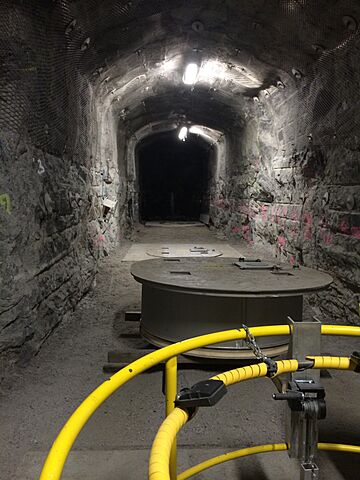
Several methods of disposal of radioactive waste have been investigated:
- Deep geological repository
- Dry cask storage
- Deep borehole disposal – not implemented.
- Rock melting – not implemented.
- Ocean disposal – used by the USSR, the United Kingdom, Switzerland, the United States, Belgium, France, the Netherlands, Japan, Sweden, Russia, Germany, Italy and South Korea (1954–1993). This is no longer permitted by international agreements.
- Disposal in ice sheets – rejected in Antarctic Treaty.
- Deep well injection – used by USSR and USA.
- Nuclear transmutation, using neutron capture to convert the unstable atoms to those with shorter half-lives.
- Nuclear reprocessing such as the PUREX process allows for reuse of some radioactive materials.
- Disposal in outer space – not implemented as too expensive.
In the United States, waste management policy broke down with the ending of work on the incomplete Yucca Mountain Repository. At present there are 70 nuclear power plant sites where spent fuel is stored. A Blue Ribbon Commission was appointed by U.S. President Obama to look into future options for this and future waste. A deep geological repository seems to be favored.
Ducrete, Saltcrete, and Synroc are methods for immobilizing nuclear waste.
Accidents
A few incidents have occurred when radioactive material was disposed of improperly, shielding during transport was defective, or when it was simply abandoned or even stolen from a waste store. In the Soviet Union, waste stored in Lake Karachay was blown over the area during a dust storm after the lake had partly dried out. At Maxey Flat, a low-level radioactive waste facility located in Kentucky, containment trenches covered with dirt, instead of steel or cement, collapsed under heavy rainfall into the trenches and filled with water. The water that invaded the trenches became radioactive and had to be disposed of at the Maxey Flat facility itself. In other cases of radioactive waste accidents, lakes or ponds with radioactive waste accidentally overflowed into the rivers during exceptional storms. In Italy, several radioactive waste deposits let material flow into river water, thus contaminating water for domestic use. In France in the summer of 2008, numerous incidents happened: in one, at the Areva plant in Tricastin, it was reported that, during a draining operation, liquid containing untreated uranium overflowed out of a faulty tank and about 75 kg of the radioactive material seeped into the ground and, from there, into two rivers nearby; in another case, over 100 staff were contaminated with low doses of radiation. There are ongoing concerns around the deterioration of the nuclear waste site on the Enewetak Atoll of the Marshall Islands and a potential radioactive spill.
Scavenging of abandoned radioactive material has been the cause of several other cases of radiation exposure, mostly in developing nations, which may have less regulation of dangerous substances (and sometimes less general education about radioactivity and its hazards) and a market for scavenged goods and scrap metal. The scavengers and those who buy the material are almost always unaware that the material is radioactive and it is selected for its aesthetics or scrap value. Irresponsibility on the part of the radioactive material's owners, usually a hospital, university, or military, and the absence of regulation concerning radioactive waste, or a lack of enforcement of such regulations, have been significant factors in radiation exposures. For an example of an accident involving radioactive scrap originating from a hospital see the Goiânia accident.
Transportation accidents involving spent nuclear fuel from power plants are unlikely to have serious consequences due to the strength of the spent nuclear fuel shipping casks.
On 15 December 2011, top government spokesman Osamu Fujimura of the Japanese government admitted that nuclear substances were found in the waste of Japanese nuclear facilities.
Associated hazard warning signs
Images for kids
See also
 In Spanish: Residuo radiactivo para niños
In Spanish: Residuo radiactivo para niños


